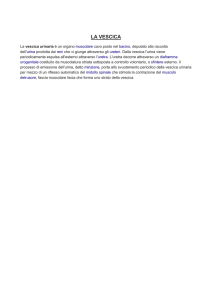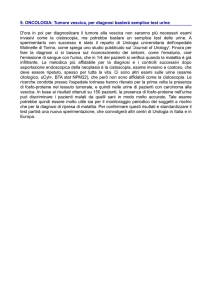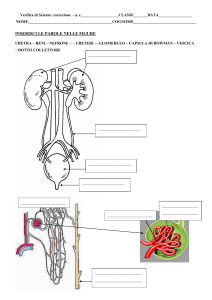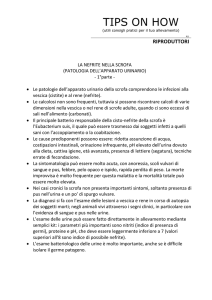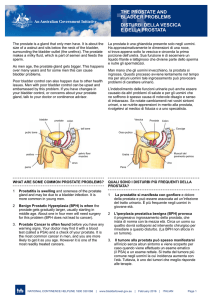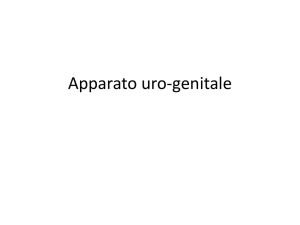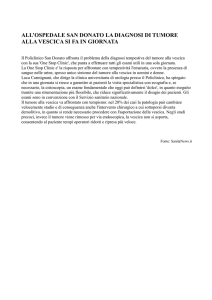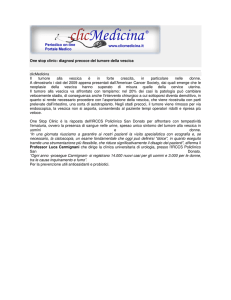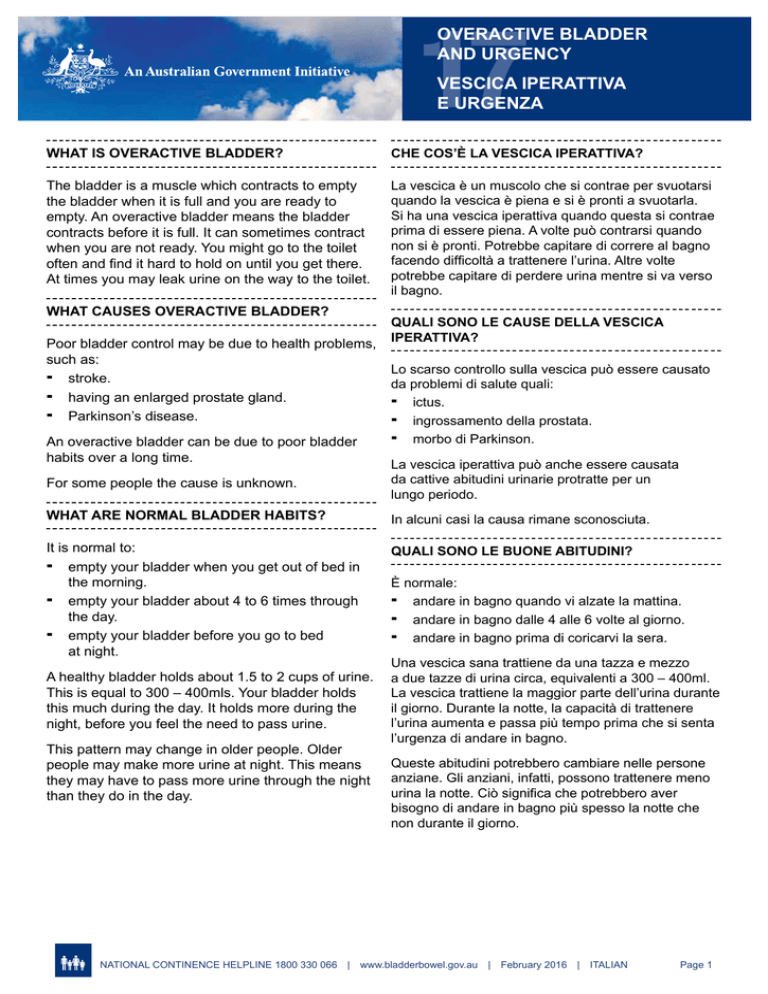
17
OVERACTIVE BLADDER
AND URGENCY
VESCICA IPERATTIVA
E URGENZA
WHAT IS OVERACTIVE BLADDER?
CHE COS’È LA VESCICA IPERATTIVA?
The bladder is a muscle which contracts to empty
the bladder when it is full and you are ready to
empty. An overactive bladder means the bladder
contracts before it is full. It can sometimes contract
when you are not ready. You might go to the toilet
often and find it hard to hold on until you get there.
At times you may leak urine on the way to the toilet.
La vescica è un muscolo che si contrae per svuotarsi
quando la vescica è piena e si è pronti a svuotarla.
Si ha una vescica iperattiva quando questa si contrae
prima di essere piena. A volte può contrarsi quando
non si è pronti. Potrebbe capitare di correre al bagno
facendo difficoltà a trattenere l’urina. Altre volte
potrebbe capitare di perdere urina mentre si va verso
il bagno.
WHAT CAUSES OVERACTIVE BLADDER?
Poor bladder control may be due to health problems,
such as:
¬stroke.
¬having an enlarged prostate gland.
¬Parkinson’s disease.
An overactive bladder can be due to poor bladder
habits over a long time.
QUALI SONO LE CAUSE DELLA VESCICA
IPERATTIVA?
Lo scarso controllo sulla vescica può essere causato
da problemi di salute quali:
¬ictus.
¬ingrossamento della prostata.
¬morbo di Parkinson.
For some people the cause is unknown.
La vescica iperattiva può anche essere causata
da cattive abitudini urinarie protratte per un
lungo periodo.
WHAT ARE NORMAL BLADDER HABITS?
In alcuni casi la causa rimane sconosciuta.
It is normal to:
¬empty your bladder when you get out of bed in
the morning.
¬empty your bladder about 4 to 6 times through
the day.
¬empty your bladder before you go to bed
at night.
QUALI SONO LE BUONE ABITUDINI?
A healthy bladder holds about 1.5 to 2 cups of urine.
This is equal to 300 – 400mls. Your bladder holds
this much during the day. It holds more during the
night, before you feel the need to pass urine.
This pattern may change in older people. Older
people may make more urine at night. This means
they may have to pass more urine through the night
than they do in the day.
È normale:
¬andare in bagno quando vi alzate la mattina.
¬andare in bagno dalle 4 alle 6 volte al giorno.
¬andare in bagno prima di coricarvi la sera.
Una vescica sana trattiene da una tazza e mezzo
a due tazze di urina circa, equivalenti a 300 – 400ml.
La vescica trattiene la maggior parte dell’urina durante
il giorno. Durante la notte, la capacità di trattenere
l’urina aumenta e passa più tempo prima che si senta
l’urgenza di andare in bagno.
Queste abitudini potrebbero cambiare nelle persone
anziane. Gli anziani, infatti, possono trattenere meno
urina la notte. Ciò significa che potrebbero aver
bisogno di andare in bagno più spesso la notte che
non durante il giorno.
NATIONAL CONTINENCE HELPLINE 1800 330 066 | www.bladderbowel.gov.au | February 2016 | ITALIANPage 1
17
OVERACTIVE BLADDER
AND URGENCY
VESCICA IPERATTIVA
E URGENZA
WHAT IS BLADDER TRAINING?
CHE COS’È L’ESERCITAZIONE DELLA VESCICA?
The aim of bladder training is to improve symptoms
of overactive bladder. Bladder training teaches
you how to hold more urine in your bladder without
feelings of urgency. Visit your doctor, a continence
nurse advisor or continence physiotherapist if you
have some problems with bladder control. They
could start you on a bladder training program. If you
do nothing about your problem, it may get worse.
Per migliorare i sintomi della vescica iperattiva
è possibile allenare la vescica. Questo tipo di
esercitazione insegna a trattenere più urina nella
vostra vescica, senza che sentiate l’urgenza di
andare in bagno. Se i sintomi della vescica iperattiva
qui illustrati vi sembrano familiari, rivolgetevi al
vostro medico di fiducia, ad un infermiere o ad un
fisioterapista specializzato in problemi di incontinenza.
Potrebbero consigliarvi di iniziare un programma
di esercitazione della vescica. Se non fate nulla al
riguardo, il problema si potrebbe aggravare.
WHAT IS IN A BLADDER TRAINING PROGRAM?
You may be asked to keep a bladder diary. You need
to keep the diary for at least 3 days. It keeps track of
how your bladder works through the day.
The bladder diary keeps track of:
¬the time you go to the toilet.
¬how much urine you pass each time.
¬how strong you felt the urge to empty each time.
The bladder diary may look something like this:
Time
6.30am
8.00am
9.00am
10.20am
12.15pm
1.25pm
2.30pm
Amount
passed
250mls
150mls
100mls
150mls
100mls
200mls
200mls
How strong was
the urge to go?
4
3
3
1
1
3
3
How do I measure the amount of urine passed?
Put a container (like an ice cream container) in the
toilet. Now sit on the toilet and relax with your feet
on the floor. Pass urine into the container. Then tip
the urine into a jug to measure it. Men may want to
stand and pass urine directly into a measuring jug.
CHE COS’È IL PROGRAMMA DI ESERCITAZIONE
DELLA VESCICA?
Potrebbe esservi chiesto di tenere un diario
minzionale; questo diario deve essere conservato per
almeno 3 giorni. Lo scopo del diario è di monitorare
il funzionamento della vescica durante la giornata.
Nel diario vanno registrati:
¬l’ora in cui si va in bagno.
¬la quantità di urina emessa ogni volta.
¬l’urgenza percepita ogni volta.
Il diario potrebbe essere organizzato così:
Ora
6.30
8.00
9.00
10.20
12.15
13.25
14.30
Quantità
emessa
250ml
150ml
100ml
150ml
100ml
200ml
200ml
Grado di urgenza
4
3
3
1
1
3
3
Come posso calcolare la quantità di
urina emessa?
Tenete in bagno un contenitore in cui urinare (ad es.
una vaschetta per il gelato). Sedetevi sul water e
rilassatevi tenendo entrambi i piedi per terra. Urinate
nel contenitore. Versate poi l’urina nel contenitore
in una brocca graduata. Per gli uomini potrebbe
essere più facile urinare in piedi direttamente nella
brocca graduata.
NATIONAL CONTINENCE HELPLINE 1800 330 066 | www.bladderbowel.gov.au | February 2016 | ITALIANPage 2
17
OVERACTIVE BLADDER
AND URGENCY
VESCICA IPERATTIVA
E URGENZA
How do I measure urgency?
Come posso misurare il grado di urgenza?
This chart shows how to use a number to describe
the urge you felt.
In questa tabella sono indicati i valori numerici
attribuibili all’urgenza che percepite.
0
No urgency.
1
Mild urgency.
2
3
4
Moderate
urgency.
Severe
urgency.
Urge
incontinence.
I felt no need to empty.
I emptied for other reasons.
I could put it off as long
as needed.
I had no fear of wetting
myself.
I could put it off for a
short time.
I had no fear of
wetting myself.
I could not put it off.
I had to rush to the toilet.
I had fear I would wet myself.
I leaked before I got to
the toilet.
How do I measure leaking using a Pad
Weight Test?
This test helps to work out how much urine you leak
over a few days. To do this test you will need some
accurate scales for weighing. You do this test by:
1. weighing a dry pad in a plastic bag before you
wear the pad,
2. then weighing the wet pad in a plastic bag after
you wear it, and
3. taking the weight of the dry pad away from the
weight of the wet pad.
This will show how much you have leaked because
each gram equals one ml.
Like this:
Wet pad
Dry pad
Weight Difference
Amount leaked =
400g.
150g.
250g.
250mls.
0
Nessun’urgenza.
1
Urgenza lieve
2
Urgenza
moderata
3
Urgenza
grave.
4
Incontinenza
da stimolo
Non sento alcun bisogno
di andare in bagno.
Sono andato/a in bagno
senza motivo.
Avrei potuto rimandare
di andare in bagno.
Non pensavo che avrei potuto
avere un’improvvisa perdita
di urina.
Non avrei potuto rimandare
di molto ancora.
Non pensavo che avrei potuto
avere un’improvvisa di urina.
Non riuscivo più a trattenerla.
Mi sono dovuto precipitare
in bagno.
Temevo proprio di avere
un’improvvisa perdita di urina.
Si è verificata perdita di
urina prima che raggiungessi
il bagno.
Come posso misurare le perdite usando
gli assorbenti?
Questo test serve a misurare quanta urina è stata
persa negli ultimi due giorni. Per farlo avrete bisogno
di una bilancia precisa. Si procede al test così:
1. si pesa l’assorbente asciutto in una busta di
plastica prima di indossarlo,
2. poi, dopo averlo indossato, si pesa l’assorbente
inserito in una busta di plastica e
3. si sottrae il peso dell’assorbente asciutto dal peso
dell’assorbente bagnato.
Si otterrà così la quantità di urina persa in quanto ogni
grammo equivale a un millilitro (ml).
Ad esempio:
Assorbente bagnato
Assorbente asciutto
Differenza di peso
Quantità persa =
400g.
150g.
250g.
250mls.
NATIONAL CONTINENCE HELPLINE 1800 330 066 | www.bladderbowel.gov.au | February 2016 | ITALIANPage 3
17
OVERACTIVE BLADDER
AND URGENCY
VESCICA IPERATTIVA
E URGENZA
WHO CAN HELP WITH YOUR BLADDER
TRAINING PROGRAM?
A doctor, continence nurse advisor or continence
physiotherapist can get the best results for you.
They will work out a program to suit you.
Some of these continence health professionals may
be in a private practice clinic. Others work in clinics
in your local community health service. They also
work in public hospital clinics. The National
Continence Helpline 1800 33 00 66 can help you
find your local continence clinic.
HOW LONG WILL IT TAKE?
Most bladder training programs take about 3
months. You may have regular meetings with
your continence nurse advisor or continence
physiotherapist. They will teach you ways to hold
on for longer. This will mean you can hold more
urine in your bladder.
SOME HELPFUL THINGS YOU WILL LEARN
FROM THE PROGRAM
Pelvic Floor Muscle Training
The continence physiotherapist or continence nurse
advisor will teach you how to use your pelvic floor
muscles. These muscles support your bladder and
urethra. The urethra is the tube that carries urine
from the bladder to the outside. Strong pelvic floor
muscles help to hold back the strong urge to pass
urine. This will help you hold on until you reach
the toilet.
Good Bladder Habits
It is normal to consume between 1.5 – 2 litres of
fluid per day unless your doctor says this is not
okay. This way your bladder will slowly learn to
stretch to hold more urine. You need to keep track
of how much you drink each day. To do this you will
need to know how much your cup or mug holds.
Cups can hold from 120 to 180mls whereas mugs
can hold 280 to 300mls or more.
DA CHI POSSO RICEVERE AIUTO DURANTE
IL PROGRAMMA DI ESERCITAZIONE
DELLA VESCICA?
Un medico, un infermiere o un fisioterapista
specializzato in problemi di incontinenza vi
aiuterà ad ottenere i risultati migliori. Con il vostro
aiuto, elaboreranno il programma migliore per la
vostra situazione.
Alcuni professionisti della salute specializzati in
disturbi della vescica operano in cliniche private.
Altri lavorano nelle cliniche del vostro servizio sanitario
comunitario. Altri ancora lavorano negli ospedali
pubblici. Potete ricevere aiuto a trovare la clinica
locale più adatta a voi telefonando a The National
Continence Helpline al numero 1800 33 00 66.
QUANTO TEMPO CI VUOLE?
La maggior parte dei programmi di esercitazione della
vescica durano circa 3 mesi. Potreste dover incontrare
regolarmente il vostro infermiere o consulente.
Saranno loro ad insegnarvi i modi per trattenere l’urina
il più a lungo possibile. Ciò significa che sarete capaci
di trattenere più urina nella vostra vescica.
ALCUNE COSE UTILI CHE IMPARERETE GRAZIE
AL PROGRAMMA
Esercitazione dei muscoli del pavimento pelvico
Il fisioterapista o l’infermiere specializzato in disturbi
di incontinenza vi insegnerà ad usare i muscoli
del pavimento pelvico. Questi muscoli sostengono
la vostra vescica e uretra. L’uretra è il tubo che
trasporta l’urina dalla vescica all’esterno. Se i muscoli
del pavimento pelvico sono forti, risulta più facile
trattenere l’urina. Rafforzare questi muscoli vi aiuterà
quindi a trattenere l’urina fino a che non sarete arrivati
in bagno.
Buone abitudini urinarie
È normale assumere fra 1 litro e mezzo e 2 litri di
liquidi al giorno, a meno che ciò non vi sia stato
sconsigliato dal vostro medico. In questo modo la
vostra vescica si abituerà a dilatarsi lentamente per
contenere più urina. Dovrete annotare la quantità
di liquidi che assumete ogni giorno. Per fare questo
dovrete sapere quanto contiene il vostro misurino
graduato. A seconda delle dimensioni, la quantità
può variare da 120 fino a 300ml e oltre.
NATIONAL CONTINENCE HELPLINE 1800 330 066 | www.bladderbowel.gov.au | February 2016 | ITALIANPage 4
17
OVERACTIVE BLADDER
AND URGENCY
VESCICA IPERATTIVA
E URGENZA
Avoid drinking fizzy drinks or drinks with caffeine.
These can upset the bladder and make it harder for
you to hold on. There is some caffeine in chocolate,
tea and coffee. There is more caffeine in cola and
sports drinks. It is best to avoid drinking these.
You will learn which drinks to choose so your
bladder will not be upset.
Good Bowel Habits
You will also learn how constipation and straining
to pass a bowel motion can stretch your pelvic floor
muscles. Avoid constipation as this also causes poor
bladder control. Eat at least 2 pieces of fruit and
5 serves of vegetables daily. Eat high fibre bread
as well.
WILL THERE BE SETBACKS?
Do not be worried by small day to day changes in
your bladder control. These are normal. Anyone
on a bladder training program can have setbacks,
when your symptoms may seem worse. This may
happen when:
¬you have a bladder infection (see your doctor
right away).
¬you are tired or run down.
¬you are worried or stressed.
¬the weather is wet, windy or cold.
¬you are ill (such as a cold or the flu).
¬you are a menstruating woman.
If set-backs do happen, do not lose heart.
Stay positive and keep trying.
È bene evitare le bevande gassate o quelle che
contengono caffeina. Queste potrebbero irritare la
vescica e rendere più difficile trattenere l’urina. La
caffeina si trova nella cioccolata, nel tè e nel caffè.
Sono a base di caffeina, e quindi ne contengono
quantità ancora maggiori, la coca cola e le bevande
per sportivi, che vi consigliamo di evitare.
Presto imparerete quali bevande scegliere per non
irritare la vescica.
Buone abitudini intestinali
Inoltre imparerete che la stitichezza e lo sforzo di
evacuazione possono dilatare la muscolatura pelvica
e causare problemi di controllo della vescica. Per
evitare la stitichezza bisogna mangiare almeno due
pezzi di frutta e cinque porzioni di verdura al giorno
oltre a consumare pane ad alto contenuto di fibre.
CI SARANNO DEGLI IMPREVISTI?
Non preoccupatevi dei piccoli cambiamenti nel
controllo della vescica che noterete di volta in volta.
È normale che ciò si verifichi. Chiunque inizi a seguire
un programma di esercitazione della vescica può
soffrire di episodi in cui i sintomi sembrano aggravarsi.
Ciò potrebbe verificarsi:
¬quando è in corso un’infezione della vescica
(consultare immediatamente un medico).
¬se siete stanchi o esauriti.
¬se siete preoccupati o stressati
¬quando c’è molta umidità, tira vento o fa freddo.
¬se siete malati (ad es. raffreddore o influenza).
¬se avete il ciclo
Se a volte vi sembra che non ci siano miglioramenti
non lasciatevi scoraggiare. Siate fiduciosi e continuate
a provare.
NATIONAL CONTINENCE HELPLINE 1800 330 066 | www.bladderbowel.gov.au | February 2016 | ITALIANPage 5
17
OVERACTIVE BLADDER
AND URGENCY
VESCICA IPERATTIVA
E URGENZA
SEEK HELP
CHIEDETE AIUTO
You are not alone. Poor bladder and bowel control
can be cured or better managed with the right
treatment. If you do nothing, it might get worse.
Non siete soli. L’incontinenza urinaria e fecale può
essere curata o gestita meglio seguendo una terapia
adatta. Se non fate nulla, potrebbe aggravarsi.
Phone expert advisors on the National Continence
Helpline for free:
¬advice;
¬resources; and
¬information about local services
Telefonate gratuitamente ai consulenti di National
Continence Helpline per ricevere:
¬consigli;
¬materiale informativo; e
¬informazioni sui servizi locali
1800 33 00 66 *
(8am – 8pm Monday to Friday AEST)
1800 33 00 66 *
(dalle 8.00 alle 20.00 dal lunedì al venerdì),
To arrange for an interpreter through the Telephone
Interpreter Service (TIS), phone 13 14 50 Monday to
Friday and ask for the National Continence Helpline.
Information in other languages is also available from
continence.org.au/other-languages
Per prenotare un interprete tramite il servizio di
interpretariato telefonico (Telephone Interpreter
Service) (TIS) chiamate il numero 13 14 50 dal
lunedì al venerdì e chiedete di parlare con la
National Continence Helpline. Queste informazioni
sono disponibili anche in altre lingue al link
continence.org.au/other-languages
For more information:
¬continence.org.au
¬pelvicfloorfirst.org.au
¬bladderbowel.gov.au
* Calls from mobiles are charged at applicable rates.
Per ulteriori informazioni:
¬continence.org.au
¬pelvicfloorfirst.org.au
¬bladderbowel.gov.au
* Le chiamate dai telefoni cellulari sono addebitate secondo
le tariffe applicabili.
NATIONAL CONTINENCE HELPLINE 1800 330 066 | www.bladderbowel.gov.au | February 2016 | ITALIANPage 6

